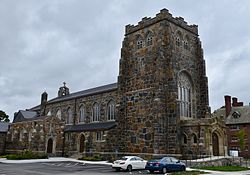| All Saints Church | |
| U.S. National Register of Historic Places | |
 | |
  | |
| Location | 211 Ashmont Street Boston, Massachusetts |
|---|---|
| Coordinates | 42°17′8.6″N 71°3′48.4″W / 42.285722°N 71.063444°W / 42.285722; -71.063444 |
| Area | 1.1 acres (0.45 ha) |
| Built | 1892 (1892) |
| Architect | Cram, Ralph Adams |
| Architectural style | Modern Gothic |
| NRHP reference No. | 80000678 |
| Added to NRHP | June 16, 1980 |
The Parish of All Saints, Ashmont, is a church of the Episcopal Diocese of Massachusetts located at 209 Ashmont Street in the Dorchester neighborhood of Boston, Massachusetts. Built 1892-1929 for a congregation founded in 1867, it was the first major commission of architect Ralph Adams Cram, a major influence in the development of early 20th-century Gothic church and secular architecture. The church was listed on the National Register of Historic Places in 1980, and is protected by a preservation easement held by Historic New England.
Architecture
All Saints is located in southern Dorchester, a short walk from the Ashmont station of the MBTA Red Line. It occupies a parcel bounded on three sides by Ashmont, Bushnell, and Lombard Streets. The main body of the church is essentially a long rectangle, with several small projection the sides, and a larger eastern projection at the southern end, joining it to the parish house. At the northern end is a large square tower with buttressed corners and a parapeted top. The front of the tower has a large stained glass window, below which an extended entrance vestibule projects forward. The church is built out of rough-face Quincy granite, with trim that is a light colored sandstone from Nova Scotia. The interior is richly decorated with Gothic features, and includes wood carvings of Johannes Kirchmayer, stone carvings by John Evans (a noted Welsh sculptor who worked on later Cram projects), and stained glass by Charles Jay Connick, another Cram friend and collaborator.
Douglass Shand Tucci said of the church: "Architect Ralph Adams Cram's first church, designed in partnership with Bertram Goodhue, was All Saints — Ashmont. A significant landmark in American architectural history, All Saints is, of its type, Cram and Goodhue's masterpiece, and a model for American parish church architecture for the first half of the 20th century."
History
The parish began in 1867 as a mission of nearby St. Mary's Church. The cornerstone for current structure was laid in November 1892, and the congregation held its first services in the new edifice December 27, 1893. Construction was financed largely through the generosity of Colonel Oliver Peabody, one of the founders of Kidder, Peabody & Co., but was not substantially completed until 1929, when the side chapels were added.
See also
References
- ^ "National Register Information System". National Register of Historic Places. National Park Service. March 13, 2009.
- ^ "NRHP nomination for All Saints Church". Commonwealth of Massachusetts. Retrieved 2017-11-10.
- Douglass Shand Tucci (1975). All Saints' Ashmont-Dorchester - Boston: A Centennial History of the Parish. Boston: The Parish.
- "A Brief History of the Parish of All Saints". Parish of All Saints. Retrieved 2013-10-31.
External links
| U.S. National Register of Historic Places in Massachusetts | |||||||||||||||||
|---|---|---|---|---|---|---|---|---|---|---|---|---|---|---|---|---|---|
| Topics |  | ||||||||||||||||
| Lists by county | |||||||||||||||||
| Lists by city |
| ||||||||||||||||
| Other lists | |||||||||||||||||
- Episcopal church buildings in Massachusetts
- Episcopal churches in Boston
- Churches completed in 1892
- 19th-century Episcopal church buildings
- Bertram Goodhue church buildings
- Gothic Revival church buildings in Massachusetts
- Churches on the National Register of Historic Places in Massachusetts
- Towers in Massachusetts
- Religious organizations established in 1867
- Ralph Adams Cram church buildings
- Stone churches in Massachusetts
- 1867 establishments in Massachusetts
- Dorchester, Boston
- Anglo-Catholic church buildings in the United States
- National Register of Historic Places in Boston